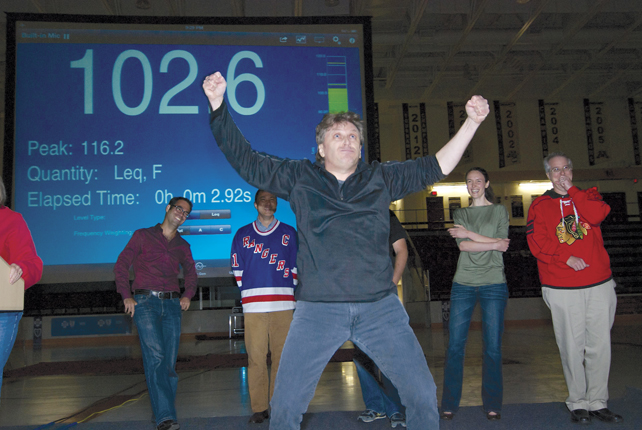Physics Slam on Ice
DOI: 10.1063/PT.3.2140
Kyle Cranmer glided into the ice arena on a sled powered by a fire extinguisher. Sarah Demers had a 900-strong audience singing about particle physics to the tune of “My Favorite Things” from The Sound of Music. At the Physics Slam on Ice, six physicists had 10 minutes each to expound on their research or something related to it. A takeoff on poetry slams, the outreach event took place on 2 August at the University of Minnesota during “Snowmass on the Mississippi,” at which hundreds of particle physicists gathered to assess their field and its future directions (see the story on page 18
“The goal was to engage the public about what we do,” says Cranmer, a physicist at New York University. “From the outside world, the Large Hadron Collider looks like a big, impersonal machine. In my slam, I didn’t try to explain my research but told my story of searching for the Higgs for 14 years—from graduating from college, going to CERN to work on the LHC, about when the LHC exploded, and when my daughter was born. It’s not like you turn on a machine and wait. There are ups and downs. I told about the unclean parts of science—people miss out on that.”
As part of an arts and sciences working group at Yale University, where she is on the faculty, Demers recently viewed a painting—possibly by Diego Velázquez—of the Virgin Mary as a child. “I was floored,” she says. “I asked myself, What am I doing with my life? Fundamental particles are identical. They’re cold.” In her slam, she says, “I tried to bring people to this point of crisis. How can I compare what I do with how moving this painting is?” Demers asked the audience to imagine the arena was a particle detector. People in certain seats stood up, and the pattern they formed was like the tracks of a particle collision. “We got lucky and got a Higgs candidate!” she says. For her, “The nature of particles saves them in the end. The fact that they don’t change means we have access to the beginning of the universe.”
The other slammers were Stuart Henderson of Fermilab, Mark Messier of Indiana University, Vladimir Savinov of the University of Pittsburgh, and Tim Tait of the University of California, Irvine. Savinov was the winner, as measured by an “applause-o-meter” (see photo). “He was a firestorm,” says Demers. “It was unbelievable. It was fantastic. It was hilarious. He started ranting about penguins. I was practically rolling on the floor laughing.”

RICHARD ANDERSON

“I spent the first three-and-a-half minutes being more and more ridiculous, schizophrenic, hyping people up,” says Savinov. “Then I jumped to hard science. I went from a global conspiracy to the Big Bang, Nobel laureates, matter and antimatter, CP violation.” Savinov says he “wanted to tell the audience something new, and make it entertaining.” And, he says, “I had never put so much effort into any presentation. Not even my faculty job interviews.”
Demers’s lyrics and a link to a video of the slam
To the tune of “My Favorite Things” in The Sound of Music; lyrics by Sarah Demers
Protons, neutrons, electrons and other leptons,
photons and gluons, W, Z and Higgs Bosons.
Standard Model physics with all the joy it brings,
these are a few of my favorite things.
Searching for dark matter, dark energy, supersymmetry
with thousands of physicists in less than perfect harmony.
Making new phenomena accessible to our machines,
these are a few of my favorite things!
When sequestration bites,
when 3AM meetings ring,
when I’m feeling sad
I simply remember my favorite things,
and then I don’t feel so bad!
Protons, neutrons, electrons and other leptons,
photons and gluons, W, Z and Higgs Bosons.
Standard Model physics with all the joy it brings,
these are a few of my favorite things.
Searching for dark matter, dark energy, supersymmetry
with thousands of physicists in less than perfect harmony.
Making new phenomena accessible to our machines,
these are a few of my favorite things!
When sequestration bites,
when 3AM meetings ring,
when I’m feeling sad
I simply remember my favorite things,
and then I don’t feel so bad!
More about the Authors
Toni Feder. tfeder@aip.org
